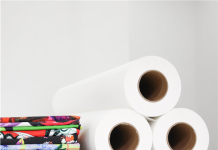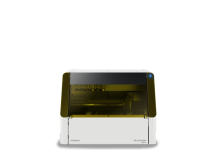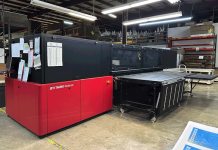According to JG Electronics, DTF printers work by printing designs onto a special film. A powder is then applied to the wet ink on the printed film. When heated, the powder melts and acts like an adhesive, allowing the design to adhere to fabric surfaces. This versatile process can also be used on paper and various porous substrates, including certain types of pseudo leather.
However, if the material is non-porous and water-resistant, the transfer won’t adhere permanently and will eventually peel off. Prints on cotton and coloured fabrics are the best digital transfers since the inception of digital transfer technology. They offer incredible colour, vibrant whites and amazing washability.
There are some issues to consider before you purchase a DTF printer.
Watch Out For Untrustworthy Sellers
The DTF industry, much like the solar market, is filled with players who make grand promises to secure your business, only to scam you out of your money and neglect your concerns afterward.
This issue is not limited to local suppliers but extends to many so-called ‘manufacturers’ as well. In reality, very few genuine manufacturers sell printers directly to customers. Instead, they produce machines for companies that rebrand them and present themselves as the original manufacturers to international dealers and distributors.
If a DTF supplier assures you that everything will be flawless and you can print anything without issues, it’s a big red flag.
Tech Support – A Mythical Beast
One significant issue arises when it comes to technical support. Often, the so-called ‘manufacturer’ lacks the expertise to resolve specific problems and must consult the actual printer manufacturer.
Even with tools like Google Translate, when a client encounters a technical issue and contacts their supplier – who speaks a different language than the ‘so-called manufacturer’, who then needs to communicate with the real manufacturer – the process becomes complicated.
This chain of communication inevitably leads to long delays, misunderstandings and incorrect solutions. These complications result in lost production time and frustration for the customer, who has invested heavily in the machine.
It’s crucial to verify whether your supplier is offering a reputable brand with an online presence and user reviews, or merely a fabricated brand that only they sell.
DTF – A Developing Technology
DTF technology is still in its developmental stages. No manufacturer has yet resolved all the potential issues, but progress is steadily being made.
Some Of The Issues With DTF Technology
1. DTF Ink Shelf Life
DTF ink has a maximum shelf life of 12 months in a sealed bottle, and once opened, this reduces to about six months at best. The challenge lies in the distribution chain. The ink manufacturers are not the ones selling the printers or interacting with the end users.
Typically, the ink is supplied to a master distributor in the country of manufacture, where it may sit in a warehouse for one to six months. It is then sold to an intermediary, who in turn sells it to a master distributor in your country.
To save on freight costs, the ink is often shipped by sea, further delaying its arrival. Finally, it is distributed through dealers and online networks before reaching the end user. This lengthy process can significantly reduce the ink’s effective shelf life by the time it is used.
This is a significant problem because, by the time the local dealer or distributor receives the ink, it may already be expired or close to its expiry date.
Expired ink, particularly white ink, often has reduced viscosity, leading to poor flow and potential blockages in the printer’s system and heads.
Many ink manufacturers use coded labels instead of clear manufacturing dates, making it difficult for customers to know the true age of the ink. As a result, customers may believe they are receiving fresh ink when it could be a year old or more.
2. Micro-bubbles in the Ink
Due to the issues mentioned in in point 1, most ink manufacturers and printer suppliers recommend shaking the ink to prevent the particles, especially in white ink, from settling at the bottom.
However, this advice is often misunderstood. Instead of shaking, the ink should be gently swirled around the container or stirred with a straw or similar device. Shaking introduces both large and micro air bubbles into the ink.
While larger bubbles may dissipate if the ink is left to sit for 10-15 minutes, micro-bubbles remain and can cause early print head failures. Although filters can remove these micro-bubbles, they are expensive and typically only found in high-end printers costing hundreds of thousands of rands.
3. Humidity And Temperature Control
DTF printers and inks require a controlled environment, typically between 18-28°C and 40-65% humidity.
Operating outside these parameters can lead to print issues, such as the white ink running out midway through a job, and can significantly reduce the ink’s shelf life. However, there are instances where the printer may function adequately even outside these limits.
4. Infrequent Printing
DTF printers are not designed for occasional use. If left idle, the ink system and expensive print heads can quickly become clogged. If your printing needs are not constant, it is more cost-effective to use a print bureau. Otherwise, you risk turning your investment into an expensive doorstop, rendering it ineffective and costly.
5. Ink Starvation
Ink starvation occurs when the ink prints fine on short jobs but stops during longer runs. This issue affects most DTF printers and many large format printers across various applications.
The causes are numerous and difficult to pinpoint, making it challenging to find a one-size-fits-all solution. A solution that works for one user often doesn’t resolve the issue for another.
The current prevailing theory suggests that ink starvation is related to the pressure within the ink system. Some believe that using ink cartridges and ink bags can mitigate this problem.
This is why major printer manufacturers are introducing new DTF printers with cartridges instead of ink bottles. As mentioned earlier, the technology is still evolving, and only time will tell if these innovations will effectively address the ink starvation issue.
6. Parts Incompatibility
Each manufacturer has unique requirements and configurations, leading to parts like motherboards being incompatible across different models or makes, even if they use the same board. This is because each manufacturer codes their boards differently. While print heads, dampers, ink lines, and some motors and gears are generally compatible, motherboards are not.
Therefore, it is crucial to purchase from a supplier who stocks parts specific to your machine. If your supplier cannot assist with repairs, you may face difficulties finding alternative repair services.
The parts are often customised for each model, making them difficult to find. Due to South Africa’s national consumer law, other repair services may also be reluctant to work on your printer.
7. Ink Viscosity
Ink viscosity, or the thickness and flow characteristics of the ink, is a critical factor that many people overlook. Printers are often designed with a specific ink viscosity in mind.
While you can purchase inks from different vendors, if the viscosity does not match the original specifications, you may encounter issues. For instance, if the ink is too thin, the colour or white layers may be inadequately applied to the film.
On the other hand, if the ink is too thick (too syrupy like), it can clog the entire ink system. Unfortunately, ink manufacturers rarely disclose the viscosity of their inks, and testing it requires specialised and expensive equipment that is typically only available in a lab setting.
8. User Maintenance
Currently, there is no DTF printer that operates without requiring daily user maintenance. While it might be possible to skip maintenance for a couple of days, this will inevitably lead to problems.
Regular maintenance tasks include cleaning around the capping station, the edges of the print head, and other critical areas. Neglecting these tasks can result in significant issues that affect the printer’s performance and longevity
9. Parts Replacement
Unlike standard inkjet printers, DTF printers require ongoing parts replacement due to the aggressive nature of the inks. Components such as capping stations, ink dampers and ink pipes will not last indefinitely and will need to be replaced periodically, depending on usage.
Print Heads Used In DTF Printers
Another often-overlooked area which you need to consider before you purchase a DTF printer is the print heads. They are one of the most expensive components of DTF printers and are not covered by warranty, as print heads are considered consumable items. Most print heads are almost exclusively manufactured by Epson, which produces different models for various applications.
To complicate matters further, suppliers or manufacturers may use either ‘remanufactured’ or new print heads. While remanufactured print heads are cheaper, the term can be misleading. Technically, it is possible to replace damaged nozzles or worn parts in a print head, but this requires expensive equipment and clean room facilities. Often, what is sold as ‘remanufactured’ has merely been cleaned, which means it may fail within days, weeks, or months, or might not work at all.
Often, neither the customer nor the seller of a DTF printer can reliably determine whether a remanufactured print head has been genuinely remanufactured or merely refurbished (cleaned). Generally, the lower the cost of the printer, the more likely it is that the print head is not new or that it uses a consumer-grade print head similar to those found in office and home printers.
The most basic print head suitable for light production DTF printers is the XP-600, which is the least expensive semi-industrial print head. For full production machines, the I1600 or I3200 print heads are recommended, depending on the printer’s size. The I1600 and I3200 are Epson’s industrial print heads, designed to handle harsher inks such as UV, DTF, and eco solvent.
The higher the specification of the print head, the more expensive it is. Industrial print heads can last between 1 to 3 years, whereas the cheapest is unlikely to last beyond 8 months and operates at a slower speed. Print heads used in home and office photo printers generally have a lifespan of only 2 to 4 months. The XP-600 has 1080 nozzles, the I1600 has 1600 nozzles, and the I3200 has 3200 nozzles.
Print Heads And Their Impact On Print Speed And Colour Quality
The specification of a print head significantly affects both print speed and colour quality. Higher-specification print heads have more nozzles, resulting in better colour output and faster printing speeds. However, this also means that the print head, and the printer, will be more expensive.
Production DTF printers typically feature dual heads: one for CMYK (colours) and the other for white ink. This dual-head setup enhances speed and provides a thicker white layer, which is particularly beneficial for printing on dark shirts.
A common question is why small-format printers do not use I3200 print heads, which are better than I1600 print heads. The reason is that I3200 print heads are designed for larger printers, with A2 being the minimum size.
For example, an A3 printer with an XP600 print head is relatively slow, taking around 15 minutes to produce an A3 print in high-quality mode. In contrast, a printer with two I1600 heads can complete the same print in approximately two minutes.
When suppliers quote print speeds, they may provide a range or just the fastest speed. For an XP-600 based machine, the print speed might be listed as 1-4 sqm per hour or simply 4 sqm per hour.
Generally, lower quality settings result in higher speeds, but this can also decrease the likelihood of customers being satisfied with the job.
RIP Software And Colour Matching
Raster Image Processing (RIP) software is a crucial component you need to consider before you purchase a DTF printer. This software directs the printer on where to apply white ink and how much of each colour to use.
It also includes useful features, such as recognising when printing on a black substrate, allowing the substrate’s black colour to be used instead of printing black ink. This not only conserves ink but also results in a softer print feel.
Colour matching is another vital function of RIP software. The colour profiles are created for a specific ink set combined with a particular transfer film. Using different inks or films can disrupt accurate colour matching, potentially leading to client dissatisfaction and job rejections.
A significant issue in the DTF printer market, especially with suppliers from the Far East, is the distribution of cracked copies of RIP software instead of original versions. These cracked copies allow suppliers to sell their machines at a lower cost, but they come with major drawbacks.
Tech support for the RIP software becomes non-existent, and users miss out on software updates that could improve print quality. Additionally, these cracked versions are often outdated compared to the latest available versions.
The good news is that DTF technology can produce amazing results when properly maintained and when the right printer is purchased for your specific needs from a reliable supplier.
A DTF printer is a significant investment that can be highly profitable. However, opting for the cheapest printer often leads to frustration and wasted money.
JG ELECTRONICS
+27 11 789 6033
sign@jge.co.za
https://www.jgelectronics.com/















